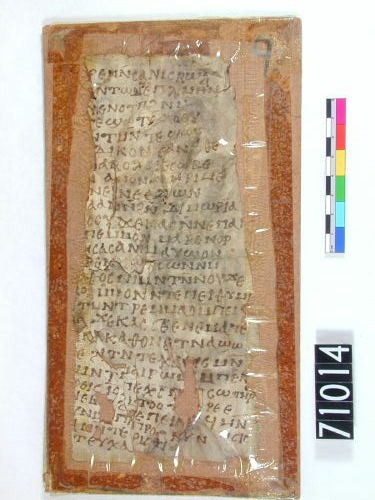Rudimentary Recording
Writing appears to have developed sometime between the 7000 and 4000 BCE. The first records were kept on stone or clay tablets. At Nineveh, around 22,000 tablets that date from the 7th century BCE were found. They represent the library and archive of the kings of Assyria, and from the sheer number of tablets we can guess that there was some system of organization or cataloging in place. Tablets actually existed much longer than one might suppose; they were in use right up through the 1800's in Germany, Chile, and the Saharan Desert.
This clay tablet comes from the library of Assur-bani-pal at Nineveh, about 668-626 BCE. It contains an account of a flood.
Meanwhile, papyrus was gaining traction in ancient Egypt. Archaeological evidence suggests that it was used as early as the First Dynasty, but the earliest example comes from the Fifth Dynasty (2400 BCE). Multiple sheets of papyrus were attached to create a longer piece, which could then be rolled up into a scroll. The title of the scroll would be printed on the cylinder that contained it. The use of the scroll also developed independently in the Americas, among the Mayans and other Pre-Colombian peoples. Unfortunately most of these were destroyed by Spanish conquistadors.

The Dresden Codex is one of the few remaining Maya scrolls. Written around the 11th or 12th century, the codex is also the oldest known book written in the Americas.
The Introduction of Parchment and Paper
In many parts of the world, parchment (made of animal hide) slowly began to replace papyrus. Legend attributes the invention to Eumenes II, the king of Pergamon. Production began around 300 BCE. The primary advantages of parchment were that it was easier to preserve than papyrus, and it could be scraped clean for reuse. However, it was also an expensive material because it took so long to produce.
The word "parchment" derives from "Pergamon," where parchment was supposedly first used. This sample, from the University College of London contains Biblical text, written in Coptic.
Writing on a wide variety of materials had existed in Eastern Asia long before 200 BCE. It makes sense, then, that paper would also be first created here. Some credit Ts'ai Louen with creating the first paper out of blackberry bush bark. Other accounts trace it back to about 105, when Cai Lun, an official of the Han Dynasty (202 BCE-220 AD) made paper from mulberry bark, fish nets, old rags, and hemp refuse.
Paper was soon used for wrapping and padding, but it didn't catch on for writing until later. First, during the Tang Dynasty it was sewn into square bags for holding tea. Then during the Song Dynasty (960-1279) it was used for the first paper currency. The introduction of water powered paper mills is really what triggered the massive production of paper. The first evidence of paper mills dates to 1282, though they may have existed somewhat sooner. Throughout the 13th century paper making centers popped up, especially in Italy. Soon, the price of paper was less than 15% the price of parchment--and quickly fell to less than that.
The Evolution of Libraries
While the materials of the written word underwent many changes throughout the years, the development and role of the library had its own transformation. Books were not originally a means for self expression; they were vehicles for knowledge and for preserving political and religious values. During the Hellenistic period, books began to spread, and the issues of cataloging and conservation came into play.Next Week: Gutenburg's revolutionary invention, the first bibliophiles, and more.








